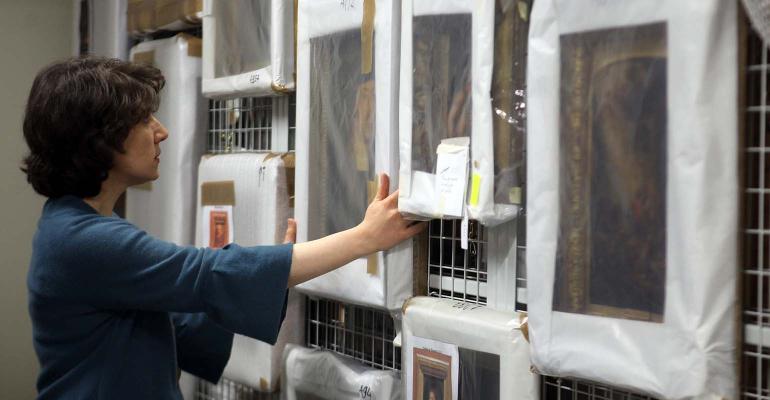If you have clients who are art collectors, they may ask for your help when it comes to selecting a warehouse to store their art. When your clients entrust their treasures to a warehouse for storage, they want assurance that their art is safe—from theft, fire and environmental hazards. Yet these physical protection issues represent only half of their risk exposure. The less obvious soft issues, such as the experience of the warehouse staff and the overall management of the warehouse operation and its finances are also important. Understanding what issues to look out for when selecting an art warehouse will help your clients make the best, most informed decisions about where to store their collections.
Factors to Consider
When individual collectors, corporate collectors, art dealers or museums choose a warehouse, cost for storage shouldn’t be the only consideration. Other factors to consider include: burglary risk mitigation, fire risk mitigation, environmental hazards owing to the location and construction of the building, climate control, humidity control factors and the experience of management and staff. These criteria may seem standard, but it’s more common than one would think that precious artwork is sometimes treated cavalierly in outside professional environments.
For example, a collector planned to transport a $3 million work of art outside of the United States and intended to warehouse the artwork prior to transport. I requested a copy of the facilities report for that location, which was a fine art warehouse. It became evident that the warehouse where the art would be stored didn’t have a fire alarm or fire mitigation system. Knowing this, the collector rearranged the transport so that the artwork would go directly from one fire-protected location to another, avoiding entirely the warehouse that lacked fire protection.
Understand the Soft Issues
Soft issues factor significantly into the successful protection capabilities of a facility. These issues aren’t obvious or easily compared. One way to gauge these soft issues is to simply look at the location and ask questions, such as:
- How well organized is the warehouse operation? Is it tidy? Are there crates in storage that are directly on the ground? Are halls free of debris?
- How experienced are the warehouse employees? What background check and review process must employees undergo? Are contract employees retained? On what basis are these individuals’ backgrounds checked in advance of hiring them? What’s the process for access to various areas of the facility?
- Have you met the professionals who will be charged with the handling of your client’s artwork?
- Is the warehouse financially sound and stable? This is a difficult question to qualify but it is relevant. When a warehouse closes operation this is a disruption and a risk
Make an Informed Decision
To understand and help reduce the risk to your clients’ collections, you should:
- Understand how long the warehouse management has been in place and their industry experience. These are typically small businesses so their facility management decisions are important.
- Require a contract that defines the obligations of the storage facility.
- Ask if the employees have training or experience in handling art and how they’re trained. Some facilities, for example, hire only artists to handle the artwork.
- Consider whether the building is multi-use. For instance, a restaurant in the same building structure wouldn’t be a desirable neighbor. Stand-alone, mono-use buildings are most secure; self-storage facilities are risky.
- Consider also the conditions and uses of nearby buildings. Would the storage facility be impacted by a fire at a building nearby?
- Determine if the environmental controls in place are adequate to protect your client’s art. “Gradual deterioration” is excluded from fine art insurance policies.
- Ask if the sprinkler system is maintained. This is especially important in older buildings. Does it have a fire detection system that instantly notifies the fire department?
- Make sure the building is clean and uncluttered.
- Determine if the size of the loading docks is sufficient to handle your client’s art and if they’re covered to protect the art from the elements.
If your client is storing artwork in a large facility, you may also want to know if the company:
- Uses a central station monitored burglary control system with cameras that monitor the facility.
- Has a process for monitoring and maintaining environmental controls, and their location.
- Performs background checks on its employees.
- Uses a barcode inventory system or a consistent alternative process to manage property and help locate items.
It’s also helpful to review facilities reports. Unfortunately, these reports, which also serve as marketing tools, aren’t standardized and sometimes not complete, making it hard to compare facilities. Ask questions and get a written contract.
Collectors, insurers and warehouses all share the same goal: to avoid damage to the artwork they own or for which they’re entrusted. Unfortunately, even with the best of intentions, not all warehouses are created equal. By knowing what potential pitfalls exist when choosing a warehouse, you can help your clients rest easy that their artwork is safe and well cared for.
Anne Rappa is a senior vice president at Huntington T. Block Insurance Agency, Inc., a division of Aon, the world’s premier insurance broker.





